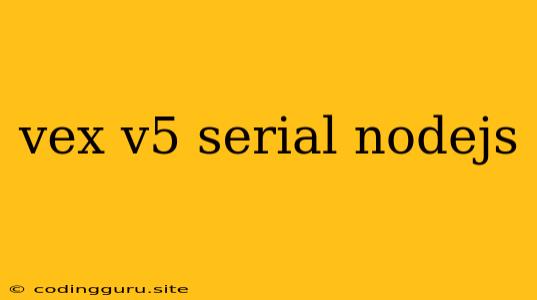Controlling Your VEX V5 Robot with Node.js: A Comprehensive Guide
The VEX V5 robotics platform is a powerful tool for STEM education and robotics competitions. While the VEX V5 programming environment offers a user-friendly interface for beginners, using Node.js allows you to unleash the full potential of your robot by leveraging the extensive libraries and flexibility of JavaScript.
This guide will walk you through the process of setting up a Node.js environment to control your VEX V5 robot, discussing essential libraries and providing practical examples.
Why Use Node.js for VEX V5 Control?
Node.js offers a compelling choice for controlling your VEX V5 robot. Here's why:
- JavaScript Expertise: If you're familiar with JavaScript, you can leverage your existing knowledge to program your robot.
- Rich Ecosystem: Node.js boasts a vast library ecosystem, including powerful libraries for robotics, communication protocols, and more.
- Real-Time Control: Node.js's asynchronous nature allows for real-time interaction with your VEX V5 robot, enabling quick and responsive control.
- Flexibility and Scalability: Node.js provides the flexibility to implement complex algorithms and manage multiple sensors and actuators.
Setting Up Your Node.js Environment
Before diving into coding, let's set up the necessary tools:
-
Node.js Installation: Download and install the latest version of Node.js from the official website. This will also install npm (Node Package Manager) for installing additional libraries.
-
VEX V5 SDK: Install the VEX V5 SDK. This SDK provides essential libraries and tools for interacting with the VEX V5 system.
- VEXcode: You can leverage the VEXcode environment for the VEX V5 platform to easily integrate your robot with Node.js.
- VEX EDR: This library is the main SDK for the VEX V5 platform that enables control and interaction with your robot's sensors and actuators.
-
Serial Communication: You'll need a way to communicate with your VEX V5 robot via a serial connection.
- VEX V5 USB Cable: Connect your VEX V5 brain to your computer using the provided USB cable.
- Serial Port Library: Install a Node.js library that allows you to access and control the serial port. Popular options include 'serialport' and 'node-serialport'.
Example Installation:
npm install serialport vex-v5-sdk
Basic Communication with VEX V5
Now that your environment is set up, let's explore basic communication with your VEX V5.
1. Establish a Serial Connection:
const SerialPort = require('serialport');
const port = new SerialPort('COM3', { baudRate: 115200 }); // Replace 'COM3' with your actual serial port
port.on('open', () => {
console.log('Serial Port Opened!');
});
port.on('error', (err) => {
console.error('Error opening port:', err);
});
2. Send Commands:
port.write('move forward', (err) => {
if (err) {
console.error('Error writing to port:', err);
} else {
console.log('Command sent!');
}
});
3. Receive Data:
port.on('data', (data) => {
console.log('Received data:', data.toString());
});
Controlling Motors and Sensors
The VEX V5 SDK provides functions for controlling motors and accessing sensor data:
Example: Motor Control:
const vex = require('vex-v5-sdk');
// Initialize motor
const motor = new vex.Motor(vex.Ports.PORT1);
// Set motor speed
motor.spin(vex.DirectionType.FWD, 100, vex.VelocityUnits.PCT); // 100% speed
// Stop motor
motor.stop(vex.BrakeType.COAST);
Example: Sensor Data:
const vex = require('vex-v5-sdk');
// Initialize sensor
const distanceSensor = new vex.DistanceSensor(vex.Ports.PORT2);
// Get distance reading
const distance = distanceSensor.distance(vex.DistanceUnits.MM);
console.log('Distance:', distance);
Advanced Robotics Control with Node.js
Node.js's power lies in its ability to handle complex tasks. Here's how you can elevate your VEX V5 robotics projects:
- Path Planning: Implement path planning algorithms to navigate your robot through complex environments.
- Obstacle Avoidance: Use sensor data to detect obstacles and adjust your robot's movement accordingly.
- Machine Learning: Train machine learning models to enhance your robot's decision-making processes.
- Internet of Things (IoT): Connect your VEX V5 robot to the internet for remote control and data analysis.
Tips for Success
- Thorough Testing: Test your code rigorously in various scenarios to ensure smooth robot operation.
- Debugging Strategies: Utilize Node.js debugging tools and logging techniques to pinpoint and resolve issues.
- Optimization: Optimize your code for efficiency and minimize latency in your robot's control loop.
- Documentation: Document your code thoroughly for maintainability and collaboration.
Conclusion
Controlling your VEX V5 robot with Node.js unlocks a world of possibilities. From basic control to advanced robotics applications, Node.js provides the foundation for creating engaging and challenging robotics projects. By combining the power of Node.js with the VEX V5 platform, you can push the boundaries of STEM education and robotics competitions.
